5 Most Spectacular Terraces in China
Terrace Fields are not only man-made agricultural masterpieces of generations, but also spectacular scenic spots chased after by countless photographers and painters. China's diverse and drastic terrains have cultivated a great number of unparalleled terrace fields that one cannot find anywhere else on the globe. Here we pick five most wonderful terraces in China worth your exploration.
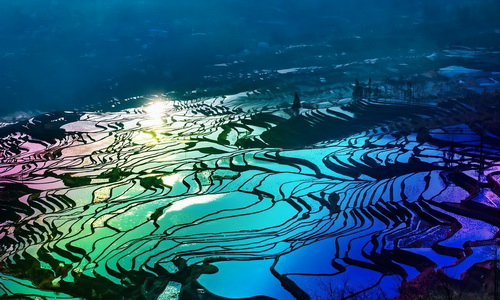
Located about 380 kilometers from Kunming City, Yuanyang Rice Terrace is an incredible agricultural work of ethnic Hani people and an enduringly scenic spectacle of Yunnan for centuries. Listed as a UNESCO World Heritage Site in 2013, Yuanyang Terrace is overwhelmingly splendid with an area of over 125sq km. Sophisticated channels cascade down from the mountaintop to the Honghe River, linking through thousands of terrace fields alongside the slope of Ailao Mountain. At the most steep side, the terraces climb up for more than 3,000 layers. With rolling fogs and clouds, the terrace looks like a work out of an artist's palette particularly at sunrise and sunset. There are mushroom-shaped straw huts, which are clustered by an array of great sights for trekking, such as Bada Scenic Spot, Duoyishu Scenic Spot and Laohuzui Scenic Spot.
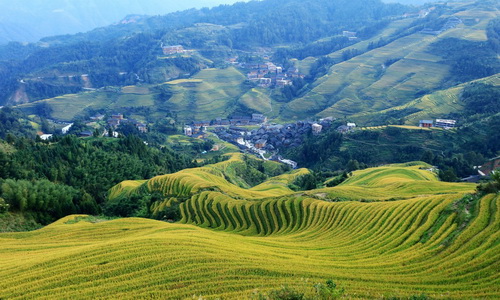
Best Time to Visit
For shutterbugs, the period from December to March is acknowledged the best time to visit Yuanyang Rice Terrace. When the great harvest is finished and the fields are flooded with water, the terrace is exceedingly marvelous like thousands of mirrors reflecting the mountains and clouds.
Photography Tips
• Duoyishu: the best site to shoot the sunrise with whirling mist from the villages.
• Bada: the best site to capture the flaming sunset glow casting down on the terrace.
Nicknamed Dragon's Bone, Longji Rice Terrace is one of the most breathtaking terraces in China. Located about 2 hours' drive from Guilin, Longji Terrace is an unrivaled agriculture gem and also one of the most photographed sites in China. Mainly made up of three scenic areas, including Jinkeng Village, Ping'an Zhuang Village and Longji Old Village, the terraced fields are carved along the hillside climbing from the riverside up to the mountain top, with an altitude rising from 300 meters to 1,100 meters. The smartly cultivated terraces stretch skyward layer upon layer on steep slopes, and some rice terraces even get gradients of 50. The ever-rising layers look like ladders reaching to the heaven, while the whole terraces cluster seems a giant oil painting unveiled between the earth and sky. When exploring this huge art work, one could also walk through the rural and traditional villages where generations of ethnic minority people like Yao and Zhuang have been residing in.
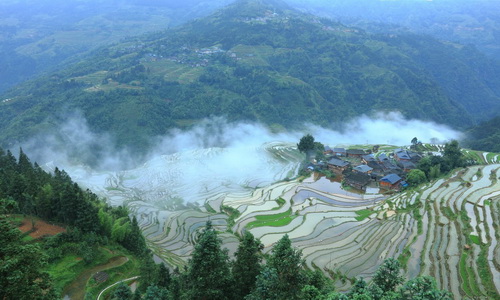
Best Time to Visit
Longji Rice Terrace can be visited all year round. From April to June, visitors are more likely to catch the mirror-like irrigated terraces and rice transplanting scene. From July to mid-September, the terraces are carpeted with refreshing greens, while one could capture the golden terraces and harvest scene probably in late September to early-November. Looking for silvery terraces, one could go during December and February.
Note: The annual harvest usually falls on National Holiday (Oct. 1-7), while it is the busiest travel time in China. The scenic area would be super crowded, and one can hardly book the accommodation, transportation and tickets. You are suggested to avoid going during that vacation or book a tour with a travel agency.
Photography Tips
• Xishan Shaoyue: It is the highest point where you could shoot amazing sunrise.
• Golden Buddha Peak (Jin Fo Ding): It is the best location to capture sunset and panoramic view of the terrace.
• Seven Stars around the Moon (Qi Xing Ban Yue) and Nine Dragons and Five Tigers (Jiu Long Wu Hu): They are the most perfect sites to snap shots of panorama of Ping'an Rice Terrace.
• Ping'an Village: There you can take amazing pictures of folk residence stilted house and ethnic women who keep their life-long hair and wear their unique tribal costume.
For an off the beaten path adventure to Guizhou, Jiabang Rice Terrace is definitely a must-see though it is a bit remote, located about 80 kilometers from Congjiang county. Jiabang Terrace boasts untouched ethnic minority villages as its highlighting backdrop. Local Miao people get the most out of the nature to carve awe-inspiring rice paddies and build arrays of stilted houses along the hillside. The most notable charm of Jiabang paddies comes from its fairylike mist and clouds lingering over the rice fields in the morning. For shutterbugs, the fascinating landscape of Jiabang Terraces promises hundreds of amazing photo chances all year round. And for explorers, the rich minority tribal culture of Miao and Dong would let you achieve unforgettable adventures deep into the rural escape of China.
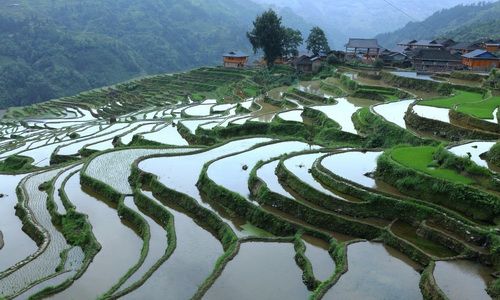
Best Time to Visit
There are two perfect periods for traveling. One is from April to June when the mirror-like rice paddies are pumped with water. The other is from September to October, the harvest time when one could see golden fields and even people reaping the rice.
Photography Tips
• Dangniu: Dangniu is a superb location to shoot the sunrise and sea of clouds.
• Jiache: Jiache is the largest rice terrace, and at the highest point a stunning panorama could be captured.
Wuyuan has been crowned as the most beautiful countryside of China, while the most scenic area of Wuyuan could be found in Jiangling. It is a rather popular photography destination famous for the gorgeous scenery of terraced fields of canola flowers and the centuries-old folk residence of Huizhou style. From the mountain top, layers upon layers of rapeseed flowers cascade down all over the hillsides and valleys, with quaint white farmhouses dotted in the middle. The idyllic beauty is not only quite a treat for your eyes, but also a gift for photographers' lenses. There are lovely walking trails covered with stones through the terrace. It is really worth and easy to navigate the winding road up to the hilltop to achieve an impressive farseeing view.
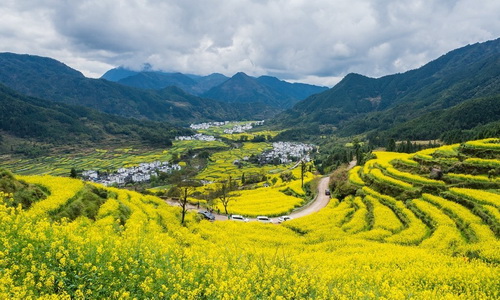
Best Time to Visit
Generally, the best time to visit Jiangling Terrace is from middle of March to early April, when one is able to see the layers of yellowish flowers in full blossom spread out all over.
Photography Tips
There are four viewing decks for shutterbugs to take wonderful shots of the terrace form all perspectives, and a lovely trail allowing one to capture the villages of ancient folk houses.
Hidden deep in Hunan province, Ziquejie Rice Terrace is less known to visitors outside China. About 3 hours' drive from Changsha City, it is probably the most remote terrace but incredibly beautiful and vast with an area of over 1,300 hectares. The terraces, some of which date back more than 2,000 years, were cultivated along the mountains by ancestors of the Miao and Yao ethnic groups. The most remarkable point of Ziquejie Terraces is its unceasing natural water resource from the forests and cracks instead of manmade pond or reservoir. Besides, the ecological rice-fish farming system makes Ziquejie terraces like no other. The terrace landscape changes by seasons. One cannot not only admire the colors of green and yellow, but also have a chance to go after the snow view in winter.
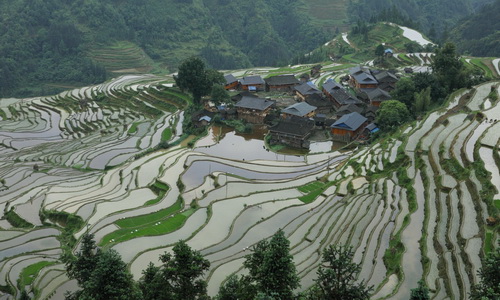
Best Time to Visit
From late March to early May, you can appreciate irrigated terraces which look like mirror pieces linked by curves. From late May to early August, it is an amazing time to go for green sprouts of terraces. And in October, visitors could embrace terraces in fully golden color that Vincent van Gogh would love.
Photography Tips
The terraces are mainly scattered in villages including Louxia, Baishui, Longpu, Shifeng, Jinlong and Laozhuang. Among which, Longpu and Shifeng are the best sites to take shots of terrace landscape. There are special lookouts for you to take stunning pictures.









